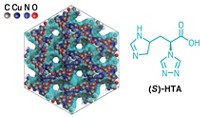Advertisement
Grab your lab coat. Let's get started
Welcome!
Welcome!
Create an account below to get 6 C&EN articles per month, receive newsletters and more - all free.
It seems this is your first time logging in online. Please enter the following information to continue.
As an ACS member you automatically get access to this site. All we need is few more details to create your reading experience.
Not you? Sign in with a different account.
Not you? Sign in with a different account.
ERROR 1
ERROR 1
ERROR 2
ERROR 2
ERROR 2
ERROR 2
ERROR 2
Password and Confirm password must match.
If you have an ACS member number, please enter it here so we can link this account to your membership. (optional)
ERROR 2
ACS values your privacy. By submitting your information, you are gaining access to C&EN and subscribing to our weekly newsletter. We use the information you provide to make your reading experience better, and we will never sell your data to third party members.
Awards
Yoshio Okamoto awarded 2019 Japan Prize for the discovery of asymmetric polymerization
Polymers developed in his lab revolutionized the separation of chiral compounds in drug discovery
by Tien Nguyen
January 16, 2019

Yoshio Okamoto, professor emeritus at Nagoya University, has been awarded the 2019 Japan Prize for his groundbreaking work in asymmetric polymerization and its practical applications in drug discovery.
“Yoshio is a great scientist and a wonderful human being,” says Christopher Welch, executive director of the Indiana Consortium for Analytical Science and Engineering. “I’m really glad to see this well-deserved recognition for innovations that have revolutionized the way that chemical and biomedical research is carried out today.”
Since 1985, the Japan Prize has been awarded annually to two scientists, or groups of scientists, of any nationality. This year’s prize also recognizes Rattan Lal of the Ohio State University for his work developing methods to sequester carbon in the soil. Chosen from the nominations of 15,000 scientists around the world, laureates receive a certificate of recognition, a commemorative metal, and a cash award of approximately $450,000.
Okamoto first introduced the concept of asymmetric polymerization 40 years ago, reporting the synthesis of a vinyl polymer with a stable helical, and thus chiral, conformation in solution (J. Am. Chem. Soc. 1979, DOI: 10.1021/ja00510a072).
Chemists considered synthetic polymer conformations completely uncontrollable until Okamoto proved otherwise, says Hokkaido University’s Tamaki Nakano, who worked in Okamoto’s lab as a graduate student. Helical structures had previously only been seen in very few synthetic polymers in the solid state and in natural polymers like proteins. “Professor Okamoto’s invention opened a way to a new generation of polymer synthesis and material design,” Nakano says.
By the early 1980s, Okamoto’s group, along with a handful of other groups, had realized a powerful application for asymmetric polymerization: chromatography. Okamoto found that the helical polymers could be used as stationary phase materials in commercial high-performance liquid chromatography columns. These chiral HPLC columns let chemists easily separate mixtures of chiral drug molecules, which had previously been an extremely difficult task. His lab also commercialized helical cellulose and amylose derivatives as HPLC column materials.
“It changed the entire regulatory policy and drug discovery industry worldwide,” says University of Texas at Arlington’s Daniel W. Armstrong, whose lab is among the original leaders in chiral separations. Since 1992, the US Food and Drug Administration has required drug companies to characterize the effects of both enantiomers of a drug, which generally requires purifying the molecules via chiral HPLC. And pharmaceutical chemists regularly use chiral HPLC for analysis and preparative scale synthesis.
More than a hundred types of chiral columns are available today but researchers still mainly rely on only a handful, Armstrong says, adding that Okamoto’s chiral columns have withstood the test of time.
Okamoto says the award comes as a great surprise and that the discovery of helical polymers and their use in HPLC columns are his proudest achievements.




Join the conversation
Contact the reporter
Submit a Letter to the Editor for publication
Engage with us on Twitter